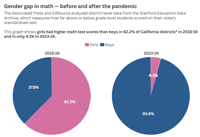
To fight California’s homelessness crisis, housing is not enough — unhoused residents also need long-term help, with federal funds now at risk.
In the nation’s most ambitious effort to address these needs, a $12 billion five-year initiative, launched in 2022 under Medi-Cal, has expanded the state’s version of Medicaid to provide services for the unhoused including stable housing navigation, rent deposit aid and tenancy-sustaining support through a program known as HTSS (Housing, Tenancy and Sustaining Services).
Medi-Cal insures nearly 15 million Californians, or 40% of the state.
In the third quarter of 2024 alone, nearly 50,000 Californians received housing navigation, deposit or tenancy services paid for by the healthcare sector.
Housing through Medi-Cal
“Housing providers do HTSS all the time. They’re involved in early identification of housing barriers, they help residents communicate with property management and they help with lease compliance and safety visits,” said Tessa Nápoles, a postdoctoral scholar with UC Berkeley’s Terner Center for Housing Innovation, at a Tuesday, April 22 briefing by the Terner Center on housing through CalAIM.
“Unfortunately, traditional housing subsidy programs often don’t provide enough funding to cover all the supportive services that residents need,” she continued. “So using medical dollars to fund HTSS is crucial for individuals who have experienced the trauma of long-term homelessness, which is often paired with unmet mental and physical health needs.”
In Terner-led statewide talks with staff of Medicaid insurance plans, known as managed care plans, “some of the initial return on investment data was not promising,” said Nápoles of CalAIM housing initiatives.
“But to me that wasn’t surprising,” she continued. “This is a very long, long game. Housing someone today is not going to mean they don’t get hospitalized tomorrow, but we are seeing that at month 12, month 18, there’s a decrease in costs in things like emergency department encounters and inpatient admissions.”
With medical funds, however, comes the uphill battle of state and federal bureaucracy, paperwork, billing, data privacy and legal requirements.
Creative ways that California’s housing organizations are navigating these include increasing per-head Medicaid funding by serving not only on-site unhoused residents but community members with less intensive housing issues, to; imposing the strictest insurance requirements across all served counties to simplify paperwork; and a “hub” model where either the local county government or a local hospital handles the administrative work, while the housing organization handles the social work.
Frank Lopez, senior program manager with Jamboree Housing — a CalAIM housing pioneer in Orange County — said “We have a housing-first model. We’re going to house somebody and then start taking care of everything else, but we wanted to find a way to sustain that housing … and a lot of times we were overwhelmed with all the documentation and the paperwork.”
To help, since the CalAIM rollout, he explained that Jamboree has collaborated with local Medi-Cal-certified organizations, most prominently Housing for Health OC, “so we’re taking their information about what services we can provide through Medi-Cal and using them to create screenings, case plans and benefit navigation for individuals that are homeless, and especially those dealing with substance abuse and mental health issues.”
While HTSS is typically approved for six or 12 months, many unhoused patients need help for much longer.
“We can’t look at health as just completing a goal, and you’re good to go. We need to get you to the point where we’re not needed anymore,” said Lopez. If patients still unready for stable housing “are achieving the goal we set in their care plans, we add a new goal. And that way, we can reauthorize HTSS. We even have people coming up to the two-year mark of working with us now.”
“When we started this program, a young woman came with domestic violence and mental health problems. She was from another country, did not understand what was going on, and was just deflated. She didn’t want to do this. CalAIM gave me the structure to show her, little by little, all the steps to get her therapy, housing, and stability to the point where now she’s housed, has a job, goes to school and doesn’t need our services anymore,“ he continued.
“In two years, she progressed from being lost and alone in this country to being within a community and supported,” Lopez added. “If it weren’t for CalAIM letting us stay with her that long to provide these services, it wouldn’t have worked … I went from thinking ‘This is not going to work out,’ to helping her prove me wrong.”
Federal cuts, state proposals
In recent weeks, however, federal officials have signaled that creative uses of medical dollars like these are in jeopardy.
Mehmet Oz, Trump-appointed Centers for Medicare and Medicaid Services administrator and former TV physician, said during his April 18 swearing-in ceremony: “This one really bothers me. There are states who are using Medicaid — Medicaid dollars for people who are vulnerable — for services that are not medical.”
The Department of Health Care Services, which administers Medi-Cal, attributes over half of all Medi-Cal spending to the 5% “of members with the highest-cost needs.”
This also comes amid a Republican-led House proposal for the largest-ever Medicaid cuts as part of a budget resolution to slash at least $880 billion through 2034 in broader health care and nutrition programs.
The House passed the measure in mid-April by a vote of 216-214; the next step is for committees to draft specific policies to implement the cuts across departments, with a non-binding deadline of May 9.
Despite this, California lawmakers are continuing to push for expansion.
The new bill AB 804, proposed by Assemblymember Buffy Wicks (D-14), for instance, would make housing support a core, statewide Medi-Cal benefit, with far less administrative burdens than its current patchwork county- and insurance plan-specific rollout.
AB 255, introduced by Assemblymember Matt Haney (D-17), would let state programs fund a new abstinence-focused recovery housing program for people coming out of substance use treatment, including eviction protections for those who relapse.
Meanwhile, DHCS is finalizing a new Transitional Rent Rule this month that provides up to six months of rent aid to help members experiencing or at risk of homelessness; the rule is optional for insurance plans this year and mandatory come January 1, 2026.
“We can’t get everybody into HTSS. We can’t get everybody a rent aid voucher. So we look at everybody this way: We’re going to try to find you housing, and we’re going to try everything along that scattered path, including property management and private landlords,” said Lopez.
“We’re not just going to have you housed and walk away. We’re going to be there to help you keep it … and CalAIM is letting us not only grow that support but bring it on-site,” he continued. “But it makes me think of the saying: ‘We’re building the plane as we fly it.’”











(0) comments
Welcome to the discussion.
Log In
Keep it Clean. Please avoid obscene, vulgar, lewd, racist or sexually-oriented language.
PLEASE TURN OFF YOUR CAPS LOCK.
Don't Threaten. Threats of harming another person will not be tolerated.
Be Truthful. Don't knowingly lie about anyone or anything.
Be Nice. No racism, sexism or any sort of -ism that is degrading to another person.
Be Proactive. Use the 'Report' link on each comment to let us know of abusive posts.
Share with Us. We'd love to hear eyewitness accounts, the history behind an article.